
The TRS-80 Micro Computer System is a desktop microcomputer launched in 1977 and sold by Tandy Corporation through their Radio Shack stores. The name is an abbreviation of Tandy Radio Shack, Z80 [microprocessor]. It is one of the earliest mass-produced and mass-marketed retail home computers.

Centipede is a 1981 fixed shooter arcade video game developed and published by Atari, Inc. Designed by Dona Bailey and Ed Logg, it was one of the most commercially successful games from the golden age of arcade video games and one of the first with a significant female player base. The primary objective is to shoot all the segments of a centipede that winds down the playing field. An arcade sequel, Millipede, followed in 1982.
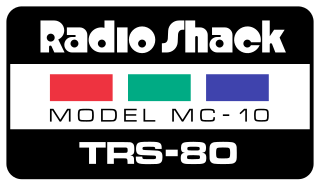
The TRS-80 MC-10 microcomputer is a lesser-known member of the TRS-80 line of home computers, produced by Tandy Corporation in the early 1980s and sold through their RadioShack chain of electronics stores. It was a low-cost alternative to Tandy's own TRS-80 Color Computer to compete with entry-level machines such as the VIC-20 and Sinclair ZX81.

Dung Beetles is an Apple II maze game written by Bob Bishop published in 1982 by Datasoft. The gameplay is similar to Pac-Man, but a portion of the maze around the player-controlled character is enlarged as if being viewed through a square magnifying glass.
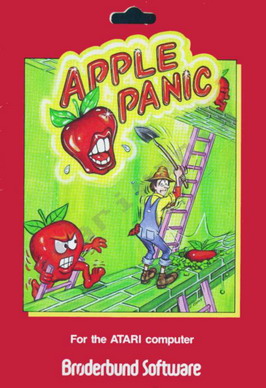
Apple Panic is a game for the Apple II programmed by Ben Serki and published by Broderbund Software in 1981. Apple Panic is an unauthorized version of the 1980 arcade game Space Panic, the first game with ladders and platforms. While the arcade original remained obscure, Apple Panic became a top seller for home computers. It was ported to the Atari 8-bit computers, VIC-20, IBM PC, and TRS-80.

The Dallas Quest is a graphic adventure game based on the television soap opera Dallas. The game was programmed by James Garon for the TRS-80 Color Computer and published by Tandy Corporation in 1984. It was the second game in the "Animated Adventure" series, following The Sands of Egypt, and uses the same split-screen display. Datasoft published versions for the Apple II, Atari 8-bit computers, and Commodore 64 in the same year.
Datasoft, Inc. was a software developer and publisher for home computers founded in 1980 by Pat Ketchum and based out of Chatsworth, California. Datasoft primarily published video games, including ports of arcade video games, games based on licenses from movies and TV shows, and original games. Like competitor Synapse Software, they also published other software: development tools, word processors, and utilities. Text Wizard, written by William Robinson and published by Datasoft when he was 16, was the basis for AtariWriter. Datasoft initially targeted the Atari 8-bit computers, Apple II, and TRS-80 Color Computer, then later the Commodore 64, IBM PC, Atari ST, and Amiga. Starting in 1983, a line of lower cost software was published under the label Gentry Software.

Meteor Mission II is a clone of the Taito arcade game Lunar Rescue released by Big Five Software for the TRS-80 home computer in 1982. It was written by Big Five co-founders Bill Hogue and Jeff Konyu.

Rear Guard is a horizontally scrolling shooter written for Atari 8-bit computers and published in December 1981 by Adventure International. Neil Larimer created the game with assistance from Sparky Starks. It was ported to the Apple II, TRS-80, and TRS-80 Color Computer.

Home computers were a class of microcomputers that entered the market in 1977 and became common during the 1980s. They were marketed to consumers as affordable and accessible computers that, for the first time, were intended for the use of a single, non-technical user. These computers were a distinct market segment that typically cost much less than business, scientific, or engineering-oriented computers of the time, such as those running CP/M or the IBM PC, and were generally less powerful in terms of memory and expandability. However, a home computer often had better graphics and sound than contemporary business computers. Their most common uses were word processing, playing video games, and programming.
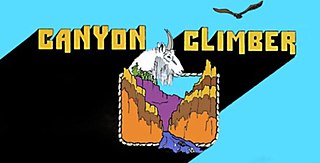
Canyon Climber is a video game designed by Steve Bjork and James Garon for the TRS-80 Color Computer and published by Tandy Corporation in 1982. Ports to other home computers were published by Datasoft. Canyon Climber is a three-screen platform game with an American Southwest theme. Two of the screens are direct analogs of those in Donkey Kong.
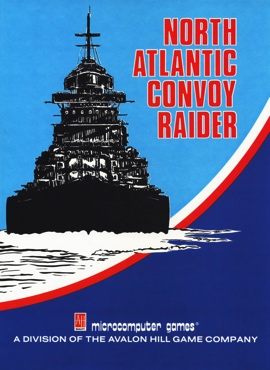
North Atlantic Convoy Raider is a wargame published by Microcomputer Games for TRS-80, Commodore PET, and Apple II in 1980. An Atari 8-bit family version was released in 1981.

Empire of the Over-Mind is an interactive fiction game written by Gary Bedrosian and published by Avalon Hill for the Apple II, Atari 8-bit computers, and TRS-80 in 1981. A version with an enhanced display for IBM PC compatibles by Bedrosian was published in 1986.

Galaxy is a 1981 video game published by Avalon Hill and developed by Microcomputer Games for the Apple II, TRS-80, Atari 8-bit family, Commodore PET, Commodore 64, IBM PC compatibles, FM-7, and TI-99/4A. It was originally published as Galactic Empires by Powersoft in 1979.
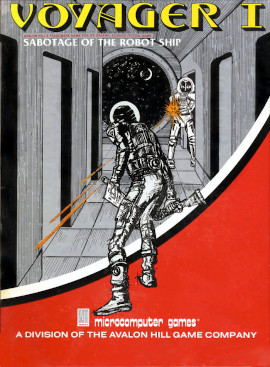
Voyager I: Sabotage of the Robot Ship is a computer game designed and programmed by William D. Volk, and published by the Microcomputer Games division of Avalon Hill. It was originally released for the Apple II in 1981, with later versions for the Atari 8-bit computers, TRS-80 Color Computer, TRS-80, and Commodore PET.

Lunar Lander is a 1980 video game published by Adventure International.

Mad Mines is a fixed shooter video game written for the TRS-80 by Yves Lempereur and published by Funsoft in 1982.

Clowns and Balloons is a circus-themed video game written by Frank Cohen for Atari 8-bit computers and published in 1982 by Datasoft. The game was also released for the TRS-80 Color Computer, written by Steve Bjork who had released a similar game called Space Ball for the TRS-80 in 1980. Clowns and Balloons is a clone of the 1977 arcade game Circus. A variant of Breakout, the player moves a trampoline left and right to catch a bouncing clown who pops rows of balloons at the top of the screen with his head.

Danger Ranger is a non-scrolling platform game designed by Ken Kalish and published in 1983 by Microdeal for the Dragon 32/64 and TRS-80 Color Computer. The game was ported to the Atari 8-bit computers and Commodore 64 by Rita Jay in 1984.



















